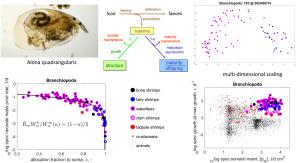当前位置:
X-MOL 学术
›
Ecol Modell
›
论文详情
Our official English website, www.x-mol.net, welcomes your feedback! (Note: you will need to create a separate account there.)
The comparative energetics of branchiopods: Adaptations to volatile environments
Ecological Modelling ( IF 3.1 ) Pub Date : 2024-04-15 , DOI: 10.1016/j.ecolmodel.2024.110721 Sebastiaan A.L.M. Kooijman
Ecological Modelling ( IF 3.1 ) Pub Date : 2024-04-15 , DOI: 10.1016/j.ecolmodel.2024.110721 Sebastiaan A.L.M. Kooijman

|
Patterns in eco-physiological traits of branchiopods are studied that are functions of underlying Dynamic Energy Budget (DEB) parameters. Most subgroups live in ephemeral waters, leaving them short time to complete their life cycle and survive as ephippia (winter-eggs) or cysts. Others, mainly the waterfleas, live of phytoplankton that show short-lasting blooms, leaving the grazers also little time to complete their life cycle. The waste-to-hurry strategy implies that branchiopods must have a high somatic maintenance to boost growth and reproduction, which is exactly what the 103 branchiopod species show in the collection of data on animal energetics and DEB parameter estimates. The consequences for assimilation are discussed. Weight at birth is linked to maximum weight for waterfleas, but not for brine, fairy, clam and tadpole shrimps. Parallels with unrelated taxa suggest that eggs size being independent of adult size is linked to metabolic acceleration. Weight at puberty is proportional to maximum weight for all groups. Maximum weight-specific neonate mass production shows little scatter as function of the allocation fraction of mobilised reserve to soma. This fraction is very high in fairy shrimps and has a broad range in waterfleas. The maximum neonate mass production was found to be proportional to the maximum respiration rate. The life-time cumulated neonate mass production is approximately equal to the maximum weight. The latter two findings for branchiopods are consistent with similar finding for many different taxa. Life span was again found to be inversely proportional to weight-specific respiration, which is remarkable for fairy shrimps: their very short life span is matched by a very high specific respiration. The fairy shrimps turn out to score lower on the supply–demand spectrum than waterfleas. Classic multidimensional scaling, applied to 12 traits of branchiopods, reveal a complete separation of Cladoceromorpha from the other Branchiopoda. The littoral chydorids and pelagic daphnids also came out separated within the Cladoceromorpha. This finding supports the common view that clam shrimps are a paraphyletic group. Article Info Supporting info: .
中文翻译:

鳃足类动物的比较能量学:对不稳定环境的适应
研究了鳃足类动物的生态生理特征模式,这些模式是基本动态能量预算(DEB)参数的函数。大多数亚群生活在短暂的水域中,因此它们有很短的时间来完成生命周期并以 ephippia(冬卵)或包囊的形式生存。其他动物,主要是水蚤,以浮游植物为食,这些浮游植物的花朵持续时间很短,使得食草动物也几乎没有时间完成它们的生命周期。 “先浪费后匆忙”策略意味着鳃足类动物必须具有较高的体细胞维持能力才能促进生长和繁殖,这正是 103 种鳃足类动物在动物能量学和 DEB 参数估计数据收集中所显示的结果。讨论了同化的后果。水蚤的出生体重与最大体重有关,但盐水虾、神仙虾、蛤虾和蝌蚪虾则不然。与不相关的类群的相似性表明,卵的大小与成体大小无关,与代谢加速有关。青春期时的体重与所有群体的最大体重成正比。最大特定体重的新生儿批量生产显示,作为动员储备分配给体细胞的比例的函数,几乎没有分散性。这一比例在仙女虾中非常高,在水蚤中也有广泛的范围。发现最大新生儿产量与最大呼吸速率成正比。一生中累积的新生儿产量大约等于最大体重。鳃足类动物的后两项发现与许多不同类群的类似发现一致。寿命再次被发现与特定重量呼吸成反比,这对于神仙虾来说是值得注意的:它们非常短的寿命与非常高的特定呼吸相匹配。事实证明,仙女虾在供需谱上的得分低于水蚤。经典的多维标度应用于鳃足类的 12 个性状,揭示了枝形纲与其他鳃足纲的完全分离。滨海乳藻类和远洋水蚤类也在枝角类中分离出来。这一发现支持了蛤虾是并系群的普遍观点。文章信息 支持信息: .
更新日期:2024-04-15
中文翻译:

鳃足类动物的比较能量学:对不稳定环境的适应
研究了鳃足类动物的生态生理特征模式,这些模式是基本动态能量预算(DEB)参数的函数。大多数亚群生活在短暂的水域中,因此它们有很短的时间来完成生命周期并以 ephippia(冬卵)或包囊的形式生存。其他动物,主要是水蚤,以浮游植物为食,这些浮游植物的花朵持续时间很短,使得食草动物也几乎没有时间完成它们的生命周期。 “先浪费后匆忙”策略意味着鳃足类动物必须具有较高的体细胞维持能力才能促进生长和繁殖,这正是 103 种鳃足类动物在动物能量学和 DEB 参数估计数据收集中所显示的结果。讨论了同化的后果。水蚤的出生体重与最大体重有关,但盐水虾、神仙虾、蛤虾和蝌蚪虾则不然。与不相关的类群的相似性表明,卵的大小与成体大小无关,与代谢加速有关。青春期时的体重与所有群体的最大体重成正比。最大特定体重的新生儿批量生产显示,作为动员储备分配给体细胞的比例的函数,几乎没有分散性。这一比例在仙女虾中非常高,在水蚤中也有广泛的范围。发现最大新生儿产量与最大呼吸速率成正比。一生中累积的新生儿产量大约等于最大体重。鳃足类动物的后两项发现与许多不同类群的类似发现一致。寿命再次被发现与特定重量呼吸成反比,这对于神仙虾来说是值得注意的:它们非常短的寿命与非常高的特定呼吸相匹配。事实证明,仙女虾在供需谱上的得分低于水蚤。经典的多维标度应用于鳃足类的 12 个性状,揭示了枝形纲与其他鳃足纲的完全分离。滨海乳藻类和远洋水蚤类也在枝角类中分离出来。这一发现支持了蛤虾是并系群的普遍观点。文章信息 支持信息: .



























 京公网安备 11010802027423号
京公网安备 11010802027423号